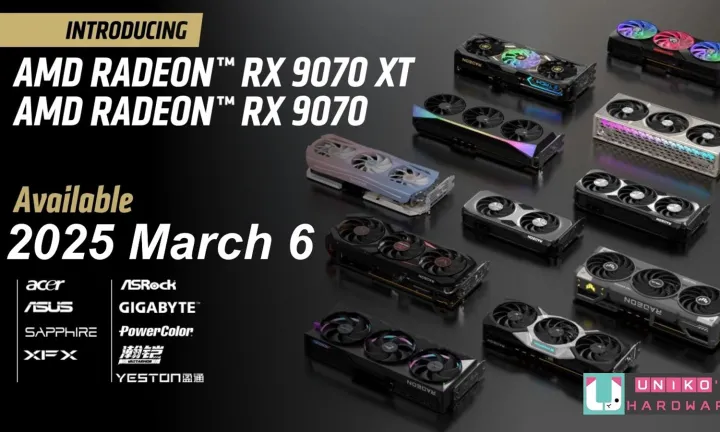Despite not being a flagship graphics card, AMD’s RX 9070 XT could be one of the most exciting graphics cards launches of the year. That’s not hyperbole either. Following the disappointing results of the RTX 5080, and lack of availability of both RTX 50 and RTX 40-series graphics cards, there is serious hype around AMD’s upcoming RX 9000 series.
But as excited as we are, that hype can only last as long as the card performs well. That’s how well it performs in isolation, and against competitor cards like the RTX 5070 Ti — another card riding the CES hype train ahead of its release.
How do these cards compare? Let’s find out.
Pricing and availability
Neither of these cards are available just yet, but that’s soon to change. The Nvidia RTX 5070 Ti is set to launch towards the end of February, with a proposed price of $750. However, the launch of the RTX 5090 and 5080 saw incredibly low stock numbers and prices that exploded, with some second-hand markets selling the cards for 2-3 times their original retail price.
 Unikos Hardware
Unikos HardwareThe RX 9070 XT is slated to launch in early March, with rumors pointing to March 6 — via UnikosHardware.
Get your weekly teardown of the tech behind PC gaming
We have no confirmed pricing information on the card yet, but AMD has said rumors of a $900 price tag are false — so, less than that. There was also a leaked listing for the card in the Philippines that had an equivalent price of around $520. That would massively undercut the 5070 Ti, which isn’t AMD’s usual strategy, so that seems unlikely.
Specs
| AMD RX 9070 XT | Nvidia RTX 5070 Ti | |
| Cores | 4,096 shader units (rumored) | 8,960 CUDA |
| RT Cores | 64 (rumored) | 70, 4th generation |
| Tensor Cores | N/A | 280, 5th generation |
| Boost clock | 2,970 MHz (rumored) | 2.45GHz |
| Memory size | 16GB GDDR6 (rumored) | 16GB GDDR7 |
| Memory bus | 256-bit (rumored) | 256-bit |
| Memory speed | Unknown | 28Gbps |
| Memory bandwidth | 624 GBps (rumored) | 896GBps |
| TBP | Unknown | 300W |
AMD hasn’t released any specifications for the RX 9070 XT just yet, so all we have to go on are rumored specifications from a Philippine store listing. The specifications are around what we’d expect this card to deliver, though — assuming it is the spiritual successor to the 7700 XT that it’s name would suggest.
The shader units and RT core counts would be around 20% higher than last-generation, and the 16GB of VRAM would be a notable upgrade over the 12GB of its predecessor. The higher clock speed would be a big increase, however, raising some eyebrows.
 Reddit / VideoCardz
Reddit / VideoCardzThe RTX 5070 Ti’s specifications are confirmed by Nvidia and locked in — we’re not expecting any on-paper surprises before its launch. The RT cores are more numerous, and probably more capable than AMD’s, even if team-red is promising big ray tracing performance improvements this generation. The faster memory and potentially greater overall bandwidth could give it an advantage when it comes to higher resolutions like 4K — though 16GB may still limit these cards in the most demanding AAA games.
Performance
AMD hasn’t told us anything about the RX 9070 XT’s performance yet, nor its architectural details — those are coming in a press conference later in February. Until we have anything official, and ultimately test these cards ourselves, we can’t say for sure how they’ll perform. We do have rumored and leaked performance results though, so let’s take a look at those.
In mid-January, some alleged results of the 9070 XT in a couple of high-end games emerged. In them, it scored 30 FPS at 4K in Black Myth: Wukong, and 26 FPS in Cyberpunk 2077 at 4K with ray tracing. That compares quite favorably with the RTX 4070 Ti, but falls behind the RTX 4080 Super.
We don’t quite know how the RTX 5070 Ti will perform yet, either, but we do have Nvidia’s graphs to go on.
 Nvidia
NvidiaAlthough in some games where multi frame generation can give it a boost, the 5070 Ti is likely to blow way past the RTX 4070 Ti, it’s more likely to actually be about 30% faster, if we consider the left-most results on the above graph. If so, that would put it well ahead of the RX 9070 XT based on those leaked performance results. Especially since as good as FSR4 will be, it’s probably not going to be as good as DLSS 4 with frame generation.
However, another set of alleged performance results leaked at the end of January, and they suggested the 9070 XT would actually handily beat the 5070 Ti. If true, that would be a big shot across Nvidia’s bow and could dramatically impact pricing of these new generation GPUs.
It’ll all come down to price
AMD has been competitive with Nvidia on performance for a long time. Not always at the top end, and it’s never quite measured up on ray tracing, but you can get a powerful AMD graphics card — usually at a price that’s far too close to Nvidia’s. With Nvidia’s better suite of overall features — DLSS is better than FSR, as much as we wish it was more competitive — its cards are often worth paying a little more for.
With the RTX 5070 Ti and RX 9070 XT, we could be looking at the 5070 Ti as the faster card, but the more expensive one, too. If AMD can price the 9070 XT around $500 and with FSR4 upscaling and frame generation, with better ray tracing support, it could be on to a real winner. If it tries to be Nvidia minus $50, though, it’s going to be poorly received.
Alternatively, if the 9070 XT is legitimately faster than the 5070 Ti, all bets are off. The price could top $800 and it might still be a cost effective choice. We’ll just have to wait and see. Fortunately, it’s not long to wait until March.















)





 English (US) ·
English (US) ·